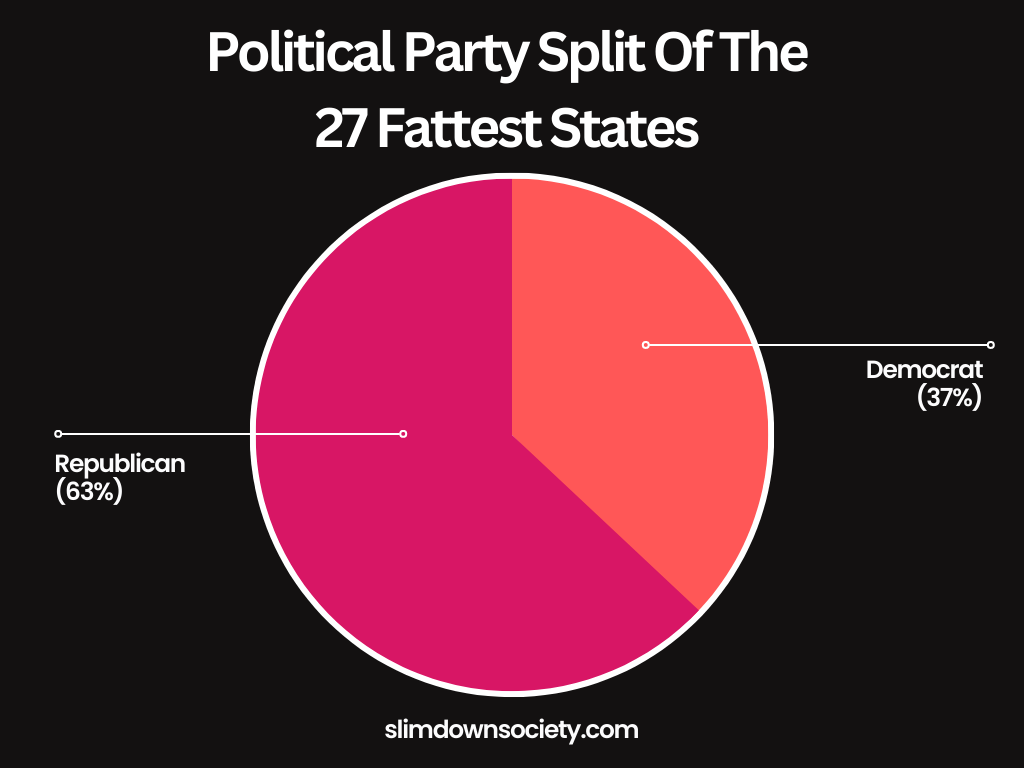Fattest States By Political Party















US Obesity Rate
Hover over a state31.9%–34.3%
34.3%–36.3%
36.3%+















US Obesity Rate
Hover over a state31.9%–34.3%
34.3%–36.3%
36.3%+















US Obesity Rate
Hover over a state31.9%–34.3%
34.3%–36.3%
36.3%+















US Obesity Rate
Hover over a state31.9%–34.3%
34.3%–36.3%
36.3%+















US Obesity Rate
Hover over a state31.9%–34.3%
34.3%–36.3%
36.3%+















US Obesity Rate
Hover over a state31.9%–34.3%
34.3%–36.3%
36.3%+





US Obesity Rate
Hover over a state31.9%–34.3%
34.3%–36.3%
36.3%+















US Obesity Rate
Hover over a state31.9%–34.3%
34.3%–36.3%
36.3%+





US Obesity Rate
Hover over a state31.9%–34.3%
34.3%–36.3%
36.3%+















US Obesity Rate
Hover over a state31.9%–34.3%
34.3%–36.3%
36.3%+
Quick Findings
- Median obesity percentage is 33.9%. Of the top 50% most obese states, 17 are republican and 10 are democrat.
- Of the top 10 obese states, 80% are republican and 20% are democrat.
- Of the 10 least obese states, 80% are democrat, and 20% are republican.
- There is a trend where obesity prevalence decreases as median income increases. Republican states tend to have lower household incomes than democratic states.
State | Obesity Prevalence (%) | Political Party | Median Income |
|---|---|---|---|
West Virginia | 40.6 | Republican | $48,037 |
Kentucky | 40.3 | Democrat | $52,238 |
Alabama | 39.9 | Republican | $52,035 |
Oklahoma | 39.4 | Republican | $53,840 |
Mississippi | 39.1 | Republican | $46,511 |
Arkansas | 38.7 | Republican | $49,475 |
Louisiana | 38.6 | Democrat | $50,800 |
South Dakota | 38.4 | Republican | $59,896 |
Ohio | 37.8 | Republican | $58,116 |
Missouri | 37.3 | Republican | $57,290 |
Iowa | 36.4 | Republican | $61,836 |
Indiana | 36.3 | Republican | $58,235 |
South Carolina | 36.1 | Republican | $54,864 |
Texas | 36.1 | Republican | $63,826 |
Kansas | 36 | Democrat | $61,091 |
North Carolina | 36 | Democrat | $56,642 |
Nebraska | 35.9 | Republican | $63,015 |
North Dakota | 35.2 | Republican | $65,315 |
Tennessee | 35 | Republican | $54,833 |
New Mexico | 34.6 | Democrat | $51,243 |
Michigan | 34.4 | Democrat | $59,234 |
Maryland | 34.3 | Democrat | $87,063 |
Illinois | 34.2 | Democrat | $68,428 |
Virginia | 34.2 | Republican | $76,398 |
Delaware | 33.9 | Democrat | $69,110 |
Georgia | 33.9 | Republican | $61,224 |
Wisconsin | 33.9 | Democrat | $63,293 |
Alaska | 33.5 | Republican | $77,790 |
Pennsylvania | 33.3 | Democrat | $63,627 |
Minnesota | 32.4 | Democrat | $73,382 |
Wyoming | 32 | Republican | $65,304 |
Maine | 31.9 | Democrat | $59,489 |
Montana | 31.8 | Republican | $56,539 |
Idaho | 31.6 | Republican | $58,915 |
Arizona | 31.3 | Democrat | $61,529 |
Nevada | 31.3 | Republican | $62,043 |
Utah | 30.9 | Republican | $74,197 |
New Hampshire | 30.6 | Republican | $77,923 |
Connecticut | 30.4 | Democrat | $79,855 |
Oregon | 30.4 | Democrat | $65,667 |
Rhode Island | 30.1 | Democrat | $70,305 |
New York | 29.1 | Democrat | $71,117 |
Vermont | 29 | Republican | $63,477 |
Washington | 28.8 | Democrat | $77,006 |
Florida | 28.7 | Republican | $57,703 |
New Jersey | 28.2 | Democrat | $85,245 |
California | 27.6 | Democrat | $78,672 |
Massachusetts | 27.4 | Democrat | $84,385 |
Colorado | 25.1 | Democrat | $75,231 |
Hawaii | 25 | Democrat | $83,173 |
District of Columbia | 24.7 | Democrat | $90,842 |
Sampling Method
The CDC Adult Obesity Prevalence Program is an active monitoring system that provides data concerning the prevalence of adult obesity in the United States. The staff at the CDC Adult Obesity Prevalence Program locations meticulously review and summarize health assessments and records from the Behavioral Risk Factor Surveillance System, a state-based telephone interview survey conducted by the CDC and state health departments.
An adult is confirmed as meeting the obesity case definition if any of the following criteria are documented in their record: a Body Mass Index (BMI) of 30 or above, a medical diagnosis of obesity found in a health assessment, or an obesity code based on the International Classification of Diseases (ICD).
Findings And Interpretation

Copy the embed code below to share the graphic above:
<a href="https://slimdownsociety.com/"><img src="https://slimdownsociety.com/wp-content/uploads/2023/04/Obesity-Political.png" alt="Obesity Prevalence Political Bias USA"></a>
Obesity prevalence across states with political preference:
- Median obesity percentage is 33.9%. Of the top 50% most obese states, 17 are republican and 10 are democrat.
- Of the top 10 obese states, 80% are republican and 20% are democrat.
- Of the 10 least obese states, 80% are democrat, and 20% are republican.
- There is a trend where obesity prevalence decreases as median income increases. Republican states tend to have lower household incomes than democratic states.
Obesity prevalence across states and territories:
- All states and territories had more than 20% of adults with obesity.
- 20% to less than 25% of adults had obesity in the District of Columbia.
- 25% to less than 30% of adults had obesity in 8 states.
- 30% to less than 35% of adults had obesity in 22 states,
- 35% to less than 40% of adults had obesity in 17 states.
- 40% or more adults had obesity in 2 states (Kentucky and West Virginia).
- The South (36.3%) had the highest prevalence of obesity, followed by the Midwest (35.4%), the Northeast (29.9%), and the West (28.7%).
Obesity prevalence varies by education level and age:
- Obesity prevalence decreased with the level of education. Adults without a high school degree or equivalent had the highest self-reported obesity (37.8%), followed by adults with some college (35.6%) or high school graduates (35.5%), and then by college graduates (26.3%).
- Young adults were half as likely to have obesity as middle-aged adults. Adults aged 18–24 years had the lowest self-reported obesity (20.7%) compared to adults aged 45–54 years who had the highest prevalence (39.3%
The CDC highlights that adults with obesity are at increased risk for many serious health conditions such as heart disease, stroke, type 2 diabetes, some cancers, and poorer mental health. Some studies have indicated that the health risks associated with obesity may occur at a lower body mass index (BMI) for some people of Asian descent. Hence, individuals are advised to regularly consult with their healthcare provider about their BMI, family history of chronic disease, current lifestyle, and health risks.
Sources
Obesity statistics sourced from the CDC Adult Obesity Prevalence Maps. Political party affiliation is sourced from the National Governors Association. Median household income sourced from World Population Review.
Contact Information
For additional information, please contact our Media Relations Team. They are available to answer questions and provide further details.
Name: Debra Sullivan
Email: [email protected]
Bio: Debra Sullivan is a highly regarded specialist in the field of weight loss and nutrition. With over a decade of professional experience, she has dedicated her career to helping individuals achieve their wellness and fitness goals.
Debra earned her Bachelor's degree in Nutrition Science from the University of Florida and went on to gain a Master's in Dietetics from the prestigious Columbia University. She is a Registered Dietitian and a Certified Personal Trainer, combining her deep understanding of food science with physical fitness to deliver comprehensive weight loss programs.
Want More?
Our next report will be about comparing obesity with religious beliefs. Want to be notified when it's published? Leave your name and email below and I'll send it to you.
